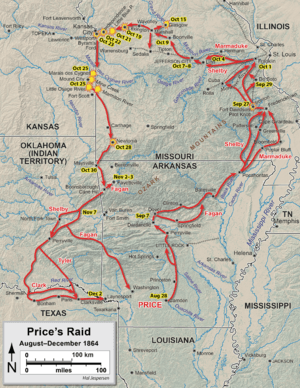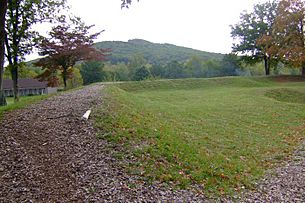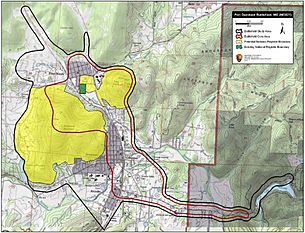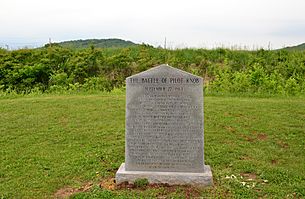Battle of Fort Davidson facts for kids
Quick facts for kids Battle of Fort Davidson |
|||||||
|---|---|---|---|---|---|---|---|
| Part of Price's Raid during the American Civil War |
|||||||
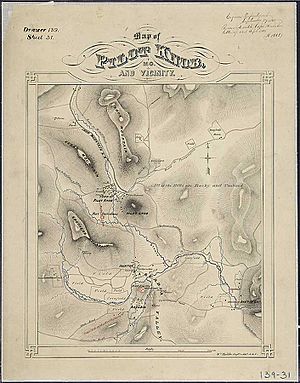 1865 map of Pilot Knob and its vicinity |
|||||||
|
|||||||
| Belligerents | |||||||
| Commanders and leaders | |||||||
| Thomas Ewing Jr. | Sterling Price | ||||||
| Units involved | |||||||
| Union garrison | Fagan's division Marmaduke's division |
||||||
| Strength | |||||||
| 1,456 | 5,700–8,700 | ||||||
| Casualties and losses | |||||||
| 213 | 500–1,000 | ||||||
The Battle of Fort Davidson, also known as the Battle of Pilot Knob, was an important fight during Price's Missouri Expedition in the American Civil War. It happened on September 27, 1864, near Pilot Knob, Missouri. Confederate soldiers, led by Major General Sterling Price, had entered Missouri in September 1864. They hoped to take control of the state from the Union.
On September 24, Price found out that Union troops were holding Pilot Knob. Two days later, he sent some of his army north to cause trouble. He then moved towards Pilot Knob with the rest of his soldiers. The Confederate groups, called divisions, led by Major General James F. Fagan and Brigadier General John S. Marmaduke, pushed Union troops back. These Union soldiers were led by Brigadier General Thomas Ewing Jr. and Major James Wilson. They were forced from the lower Arcadia Valley into Fort Davidson on September 26 and the morning of September 27.
On the afternoon of September 27, Price arranged his troops to attack Fort Davidson from many sides. The attacks were supposed to happen at the same time, but they didn't. Each attack happened separately and was pushed back by the Union defenders. Brigadier General William L. Cabell's Confederate group, called a brigade, attacked the fort three times. On their last try, they managed to cross the fort's moat, which is a ditch around the fort. However, they couldn't get inside the fort itself.
That night, General Ewing decided to leave the fort. His soldiers blew up the fort's magazine, which stored gunpowder. They then quietly slipped past the Confederate soldiers who were guarding the escape routes. Some of Price's men chased Ewing the next day, but they eventually stopped to rejoin Price's main army. Because his troops were tired and discouraged from the failed attacks at Fort Davidson, Price decided not to attack St. Louis. The Confederate army then moved west. They were later defeated at the Battle of Westport on October 23. Price's men then went back to Texas, losing more battles along the way. Today, the site of Fort Davidson is a Missouri State Park and is listed on the National Register of Historic Places.
Contents
Why the Battle Happened
When the American Civil War started in 1861, Missouri was a state where slavery was allowed, but it did not leave the United States. However, the state was divided. The governor, Claiborne Fox Jackson, and the Missouri State Guard supported leaving the Union and joining the Confederate States of America. On the other side, Brigadier General Nathaniel Lyon and the Union Army supported the United States.
In 1861, Major General Sterling Price and the Missouri State Guard won battles at Wilson's Creek and Lexington. But by the end of the year, Price's forces were mostly in the southwestern part of Missouri. In March 1862, the Confederates lost the Battle of Pea Ridge in Arkansas. This gave the Union control of Missouri. After this, Confederate actions in Missouri were mostly small guerrilla attacks and raids.
By September 1864, the war was going badly for the Confederates in the eastern United States. The Union's victory in the Atlanta campaign helped Abraham Lincoln in the 1864 United States presidential election. At this point, the Confederates had little chance of winning the war.
General Edmund Kirby Smith, the Confederate commander in the Trans-Mississippi area (west of the Mississippi River), was told to send his soldiers to the main fighting areas. But this was impossible because the Union Navy controlled the Mississippi River. Smith decided that an attack in Missouri would help by making the Union send troops there, instead of to the main battles. Price and the Confederate Governor of Missouri, Thomas Caute Reynolds, suggested invading Missouri. Smith agreed and put Price in charge.
Price hoped his attack would cause people in Missouri to rise up against Union control. He also wanted to draw Union troops away from other battles. Many Union soldiers had already left Missouri, leaving the state's defense to local militias. Price also hoped his invasion would help George B. McClellan win the election against Lincoln. On September 19, Price's army, called the Army of Missouri, entered the state.
Getting Ready for Battle
When Price entered Missouri, he had about 13,000 men. Many of them were poorly armed or had no weapons. His force had 14 cannons, but they were small and not very effective against strong forts. Price's army was split into three divisions, led by Major General James F. Fagan, Brigadier General John S. Marmaduke, and Brigadier General Joseph O. Shelby.
About 10,000 Union soldiers were spread across Missouri. Around 3,000 of them were in the St. Louis area, commanded by Brigadier General Thomas Ewing Jr.. Many of Ewing's men were from the Missouri State Militia (MSM) or the Enrolled Missouri Militia (EMM). While MSM soldiers had experience fighting guerrillas, the EMM soldiers were not well trained or equipped.
On September 24, Price learned that Union troops held the town of Pilot Knob and a railroad end. Price didn't want Union forces behind him, so he decided to attack them. He sent Shelby's division north of Pilot Knob on September 26 to damage the railroad. He sent Fagan and Marmaduke directly against the Union troops. Ewing's Union force near Pilot Knob had 1,456 men: 856 Union Army soldiers, 450 MSM men, and 150 armed civilians. Price also learned on September 25 that Union Major General Andrew Jackson Smith and 8,000 men were near St. Louis. This made Price doubt if he could take St. Louis.
On September 26, Price's army moved from Fredericktown towards the Arcadia Valley. Fagan's division led the way. The entrance to the valley, Shut-In Gap, was not guarded. Fagan sent Colonel William F. Slemons's brigade, led by Colonel John C. Wright, ahead. Wright, with about 250 men, surprised a small Union group. This group managed to send a warning to Union soldiers in Ironton and at Fort Davidson.
Ewing sent 80 men from the 3rd MSM Cavalry to check the reports. Wright's men scattered the MSM soldiers but were stopped by Union infantry when they tried to go through Ironton. Ewing heard the fighting and sent Major James Wilson with several hundred cavalrymen to the battle. Ewing then followed with soldiers from the 14th Iowa Infantry Regiment and two cannons. The Union groups joined in Ironton around 3:00 PM. Wilson attacked and pushed Wright back towards the gap. Ewing thought he was fighting Shelby's men. He left Wilson in the valley and went back to Fort Davidson. He then got ready to defend the fort and sent extra supplies by railroad to Smith.
As more Confederate troops came through Shut-In Gap, Wilson realized he was facing a very large enemy force. Around 10:30 PM, Ewing let Wilson pull back to a safer spot near Ironton. The reports also made Ewing unsure about holding Pilot Knob. That night, he asked his officers what they thought was best. After talking, Ewing decided to hold the fort. He was worried that his poorly trained soldiers might not stay together during a retreat. Ewing and Colonel Thomas Clement Fletcher also wanted to fight because they thought retreating would hurt their political careers. Supplies and some civilians were sent away by train.
About Fort Davidson
Fort Davidson is near Pilot Knob, Missouri. This town is in a flat area between four hills: Pilot Knob, Shepherd Mountain, Rock Mountain, and Cedar Hill. Before Fort Davidson, there was an older fort called Fort Hovey (later Fort Curtis). It was built by Union soldiers in 1861 south of where Fort Davidson would be. Fort Curtis had large cannons.
Fort Curtis was not in a good spot to guard the important local iron mines and a nearby railroad. So, Fort Davidson was built in 1863 near the base of Pilot Knob. It was built to better protect these important places.
Fort Davidson was shaped like a hexagon and had walls made of earth. The walls were about 100 to 150 feet long and 5 to 9 feet high. Two rifle pits, which are like trenches, were built: one to the north and one to the southwest. The fort's magazine, where gunpowder was stored, was underground inside the fort. It had 15 feet of dirt and wood planks for protection. An inspection in 1864 found that the surrounding mountains could allow enemy fire to hit the fort from the side, which is called enfilade fire.
Around the fort was a moat, a ditch about 10 feet wide. This moat was about 6 to 8 feet deep. Fort Davidson was named after Brigadier General John Wynn Davidson, who had commanded Union troops in the area in 1862.
The Battle Begins
By the morning of September 27, Marmaduke's men had joined Fagan's. That morning, the combined Confederate force attacked and pushed Wilson back. The Confederates eventually took the land between Shepherd Mountain and Pilot Knob. At 9:15 AM, Union cannons from the fort fired and drove away Confederate troops coming from Ironton. However, men from the 14th Iowa Infantry, who were holding a position forward, were accidentally hit by fire from both the fort and Wilson's 3rd MSM Cavalry on Pilot Knob. This made the Iowans pull back into Fort Davidson.
Ewing was offered a chance to surrender, but he refused. He was worried that Price's men might harm him because of some unpopular decisions he had made earlier. Confederate cannons then fired at Wilson's men on Pilot Knob, who also pulled back into the fort. After Wilson left, the Confederate guns fired at Fort Davidson, but they didn't do much damage. With Wilson gone, Fagan moved his men to the area between Pilot Knob and Rock Mountain. They started taking things from houses until Union cannon fire made them move to the other side of Pilot Knob.
Meanwhile, Confederate troops began getting ready to attack. The brigades of Slemons and Colonel Thomas H. McCray lined up on Pilot Knob. Brigadier General William L. Cabell's brigade was in the gap between Pilot Knob and Shepherd Mountain. Brigadier General John Bullock Clark Jr.'s brigade was on Shepherd Mountain. Colonel Thomas R. Freeman's brigade and Slayback's Missouri Cavalry Battalion were north of Shepherd Mountain. Colonel Archibald S. Dobbins's brigade was also north of the town, ready to block any Union escape.
Price's plan was for all attacks to happen at the same time. Historians estimate that Price had about 4,700 to 8,700 men ready to attack the fort. Fagan and Marmaduke thought a direct attack would quickly take the fort. But Price's chief engineer suggested putting cannons on Shepherd Mountain to bombard the fort until it surrendered.
To help the attack, the Confederates tried to move four cannons onto Shepherd Mountain. But only two guns could be moved into position because the ground was too rough. In the early afternoon, Ewing sent some of the 14th Iowa Infantry to check the Confederate positions. They were pushed back by heavy fire. Wilson was also sent to hold the town of Pilot Knob. The two Confederate cannons on the mountain tried to shell the fort but had little success. Around 2:00 PM, the main Confederate attack began. The Confederate attacks were not well coordinated, which allowed the Union troops to push them back one by one.
Clark's and Cabell's brigades started the attack. Part of Clark's brigade joined Cabell's men. After crossing a creek, some Confederates reached the fort's moat before firing. Their shots didn't do much because sandbags stopped most of them. Fort Davidson had more than twice the number of soldiers it was designed for. Ewing used this by having some men load weapons while others fired. This created heavy fire that pushed Cabell's and Clark's men back to the creek bank. Some Confederates, like the 4th Missouri Cavalry Regiment and the 8th Missouri Cavalry Regiment, didn't get further than the creek.
When Slemons's and McCray's men attacked the fort from Pilot Knob, they captured Wilson and scattered his men. But when the Confederates came under fire from the fort, they quickly broke and ran. Wright, now back in command of his regiment, led his men with Cabell's. They got almost to the moat before being pushed back. Later, Cabell's brigade attacked again, this time with two cannons, but they were pushed back again.
North of the fort, Slayback's and Freeman's men finally attacked at 4:00 PM. They sent some men to bother Union wagons near Rock Mountain. Then they attacked the northern rifle pits with the rest of their forces. The Union defenders, men of the 3rd MSM Cavalry, eventually retreated. But the Confederates couldn't take the fort and fell back. Cabell ordered his brigade to make a third attack. Some of his men were able to cross the moat. But Union defenders threw hand grenades, driving them away. Cabell's remaining soldiers fell back past the creek. Clark's men left the creek line after dark.
After the fighting stopped, Commander Alonzo W. Slayback sent a message to Ewing. He said that any African Americans inside the fort would be killed if captured. Price decided to try more attacks the next day. Believing the moat was the main problem, Price ordered his men to build ladders overnight to cross it. Meanwhile, Ewing decided to leave the fort that night. The Union soldiers quietly slipped past Dobbins's brigade, which was surrounding the fort. A group at the end blew up Fort Davidson's magazine. The Confederates didn't notice the escape or react to the explosion. Union casualties were 213. Confederate casualties were between 500 and 1,000. Cabell's brigade lost about 10 percent of its men.
What Happened Next
Ewing's remaining soldiers retreated towards Rolla through Leasburg. Shelby's and Marmaduke's men chased them for a while. Price took Fagan's division north, destroying railroad stations along the way. The Confederates chasing Ewing eventually stopped and rejoined Price's main army on September 29. On October 1, Confederate troops took over the town of Pacific, which was less than 40 miles from St. Louis.
The Confederate soldiers were sad and discouraged by the bloody attacks. The attacks also showed that Price's army was not very strong. Price decided to cancel the attack on St. Louis. Instead, he moved west towards the state capital, Jefferson City.
On October 7, Price's army reached high ground near Jefferson City. However, Price, remembering the failed attacks at Fort Davidson, decided that the city's defenses were too strong to attack. He continued moving west. With Union troops near the Kansas-Missouri border and more following him, Price's army moved towards Kansas City, Missouri. They fought several small battles along the way. On October 23, Price was defeated near Kansas City by a large Union force in the Battle of Westport.
The Confederates retreated back through Kansas. They suffered more defeats, including a terrible loss at the Battle of Mine Creek on October 25. There, Marmaduke and hundreds of other men were captured. Union troops chased Price's defeated army all the way to the Arkansas River. The Confederates eventually retreated all the way to Texas. During the whole campaign, Price lost more than two-thirds of his men.
Fort Davidson Today
In 1968, the Battle of Pilot Knob State Historic Site became part of the Missouri State Parks system. The fort was also added to the National Register of Historic Places on February 26, 1970. A large grave for soldiers who died in the battle is marked by a granite monument. The fort's walls and the crater from the magazine explosion can still be seen at the site.
There is a visitors center at the site. It has a research library, a special display with lights, and old items from the battle. These items include General Ewing's sword. The American Battlefield Trust has helped protect 41 acres of land at the site.
See also
 In Spanish: Batalla de Fort Davidson para niños
In Spanish: Batalla de Fort Davidson para niños


